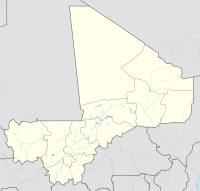Gao-saney
Coordinates: 16 ° 15 ′ N , 0 ° 0 ′ W
Gao-Saney is the North African trading town of Gao on the eastern Niger knee in Mali . It is four kilometers east of the royal city of Gao.
Gao-Saney owes its fame to the fact that the grave stelae of kings were discovered here in 1939 . The dated inscriptions on these steles from Almería in southern Spain attest to the existence of a Muslim dynasty at the end of the 11th / beginning of the 12th century AD, whose first three rulers bore the names of the prophet and the first two caliphs .
According to recent research, the kings of the stelae of Gao-Saney, the Zaghe , are identical to the Za of the Chronicles of Timbuktu . The inscriptions on the main steles contain the names of the Prophet Muhammad and those of his two successors. Only the third royal inscription also provides a local name and thus enables the Zaghe to identify with the kings of the Za and thus opens a new chapter in the history of the Songhay that has yet to be written:
| Kings of Gao-Saney (A.D. 1100 to A.D. 1120) | |||||||||||||
| Gao-Saney steles | Ta'rīkh al-fattāsh | Ta'rīkh al-sūdān | |||||||||||
|---|---|---|---|---|---|---|---|---|---|---|---|---|---|
| Kings of the Zaghe | date of death | Kings of the Zā | Kings of the Zā | ||||||||||
| Abū 'Abd Allāh Muhammad st. 1100 | st. 1100 | (16) Kotso-Dare | (16) Kusoy-Dare | ||||||||||
| Abū Bakr b. Quhāfa st. 1110 | st. 1110 | (17) Hizka-Zunku-Dam | (17) Hunabonua-Kodam | ||||||||||
| Umar b. al-Khattab = | |||||||||||||
Due to the identity of the Yama b. Kima (alias Umar b. Al-Khattab), the third king of the stelae of Gao-Saney, with Yama -Kitsi, the 18th ruler of the Songhay king list of the Ta'rikh al-Fattash , written in 1665 in Timbuktu , can the kings of the Steles of Gao-Saney can be equated with the kings of the Za. The correctness of this identification is confirmed by an indication of the Ta'rikh al-Sudan from 1655, the second chronicle of Timbuktu, which bears the name Biyu-Ki- Kima at the 18th position on the Za king's list . The equation of a king of the stelae of Gao-Saney with a king of the Za makes it possible for the first time to put the dynasty history of the Gao Empire on a source-critical foundation.
bibliography
- John Hunwick, "Gao and the Almoravids: a hypothesis," in B. Swartz and R. Dumett (eds.), West African Culture Dynamics , The Hague, 413-430.
- Timothy Insoll: Islam, Archeology and History: Gao Region (Mali) ca AD 900-1250 , Oxford 1996.
- Dierk Lange: Rois de Gao-Sané et les Almoravides " , Journal of African History 32 (1991), 251-275.
- -: Ancient Kingdoms of West Africa , Dettelbach 2004 (here pp. 495-544).
- -: “Review by P. Moraes Farias, Medieval Inscriptions (2003)” (PDF; 252 kB), Afrika und Übersee , 87 (2004), 302-5
- Paolo de Moraes Farias: Arabic Medieval Inscriptions from the Republic of Mali , Oxford 2003 (for the three kings see pp. 3, 7–8, 15).
- Jean Sauvaget: "Les épitaphes royales de Gao", Bulletin de l'IFAN , Series B, 12, 1950, 418-440.
